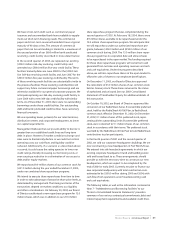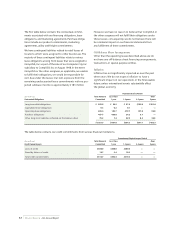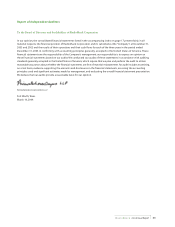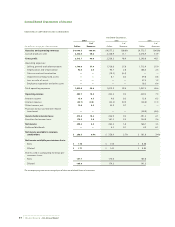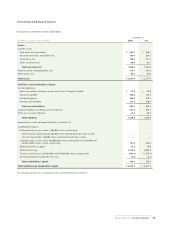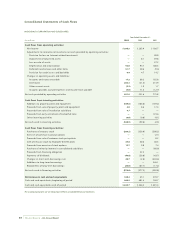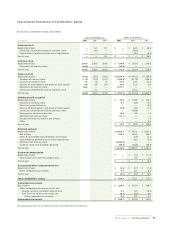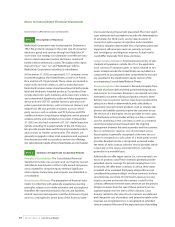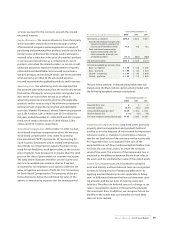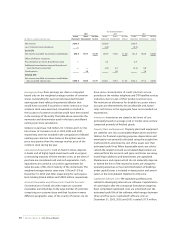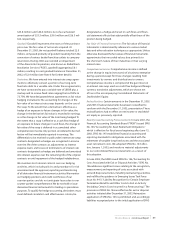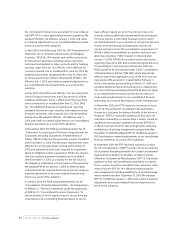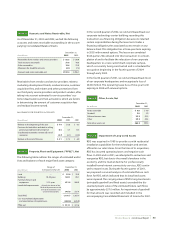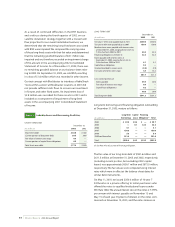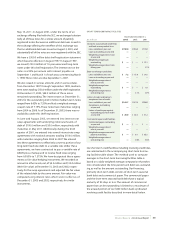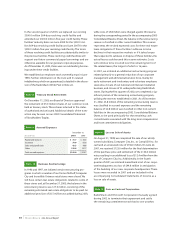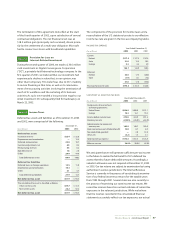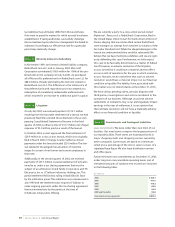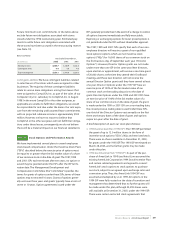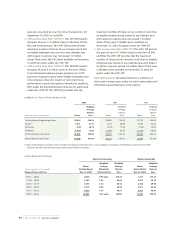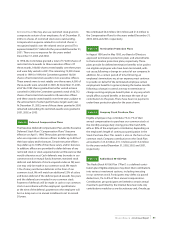Radio Shack 2003 Annual Report Download - page 43
Download and view the complete annual report
Please find page 43 of the 2003 Radio Shack annual report below. You can navigate through the pages in the report by either clicking on the pages listed below, or by using the keyword search tool below to find specific information within the annual report.
RADIOSHACK 2003 Annual Report 41
$43.8 million and $46.6 million, net of accumulated
amortization of $53.3 million, $39.0 million and $26.3 mil-
lion, respectively.
Goodwill: Goodwill represents the excess of the purchase
price over the fair value of net assets acquired. At
December 31, 2003, the net goodwill balance totaled $2.9
million, composed primarily of goodwill resulting from the
conversion of various dealer/franchise outlets to company
retail stores.During 2002, we recorded an impairment
of the AmeriLink Corporation, also known as RadioShack
Installation Services (“RSIS”), goodwill aggregating $8.1
million, resulting in a net goodwill balance at December 31,
2002, of $2.9 million (see Note 6 for further details).
Derivatives: We have entered into interest rate swap agree-
ments to effectively convert a portion of our long-term
fixed rate debt to a variable rate. Under these agreements,
we have contracted to pay a variable rate of LIBOR plus a
markup and to receive fixed rates ranging from 6.950% to
7.375%.We have designated these agreements as fair value
hedging instruments.The accounting for changes in the
fair value of an interest rate swap depends on the use of
the swap.To the extent that a derivative is effective as a
hedge of an exposure to future changes in fair value, the
change in the derivative’s fair value is recorded in earnings,
as is the change in fair value of the item being hedged.To
the extent that a swap is effective as a cash flow hedge of
an exposure to future changes in cash flows, the change in
fair value of the swap is deferred in accumulated other
comprehensive income. Any portion considered to be inef-
fective will be immediately reported in earnings.The
differentials to be received or paid under interest rate swap
contracts designated as hedges are recognized in income
over the life of the contracts as adjustments to interest
expense. Gains and losses on terminations of interest rate
contracts designated as hedges are deferred and amortized
into interest expense over the remaining life of the original
contracts or until repayment of the hedged indebtedness.
We maintain strict internal controls over our hedging
activities, which include policies and procedures for risk
assessment and the approval, reporting and monitoring
of all derivative financial instrument activities.We monitor
our hedging positions and credit worthiness of our
counter-parties and do not anticipate losses due to our
counter-parties’nonperformance.We do not hold or issue
derivative financial instruments for trading or speculative
purposes.To qualify for hedge accounting, derivatives must
meet defined correlation and effectiveness criteria, be
designated as a hedge and result in cash flows and finan-
cial statement effects that substantially offset those of the
position being hedged.
Fair Value of Financial Instruments: The fair value of financial
instruments is determined by reference to various market
data and other valuation techniques as appropriate. Unless
otherwise disclosed, the fair values of financial instruments
approximate their recorded values, due primarily to
the short-term nature of their maturities or their varying
interest rates.
Comprehensive Income: Comprehensive income is defined
as the change in equity (net assets) of a business enterprise
during a period, except for those changes resulting from
investments by owners and distributions to owners.
Comprehensive income is comprised of the gain (loss) on
an interest rate swap used as a cash flow hedge and foreign
currency translation adjustments, which are shown net
of tax in the accompanying Consolidated Statements of
Stockholders’ Equity.
Reclassifications: Certain amounts in the December 31, 2002
and 2001, financial statements have been reclassified to
conform with the December 31, 2003, presentation. These
reclassifications had no effect on net income or stockhold-
ers’equity as previously reported.
Recently Issued Accounting Pronouncements: In June 2001, the
Financial Accounting Standards Board (“FASB”) issued SFAS
No.143,“Accounting for Asset Retirement Obligations,”
which is effective for fiscal years beginning after June 15,
2002. SFAS No. 143 establishes financial accounting and
reporting standards for obligations associated with the
retirement of tangible long-lived assets and the associated
asset retirement costs. We adopted SFAS No. 143 effec-
tive January 1, 2003, and made no material adjustments
to our consolidated financial statements as a result of
this adoption.
In June 2002, the FASB issued SFAS No. 146,“Accounting for
Costs Associated with Exit or Disposal Activities.” SFAS No.
146 addresses significant issues relating to the recognition,
measurement, and reporting of costs associated with
exit and disposal activities, including restructuring activities,
and nullifies the guidance in Emerging Issues Task Force
Issue No. 94-3,“Liability Recognition for Certain Employee
Termination Benefits and Other Costs to Exit an Activity
(Including Certain Costs Incurred in a Restructuring).”The
provisions of SFAS No. 146 are effective for exit or disposal
activities initiated after December 31, 2002. Retroactive
application of SFAS No. 146 is prohibited and, accordingly,
liabilities recognized prior to the initial application of SFAS


